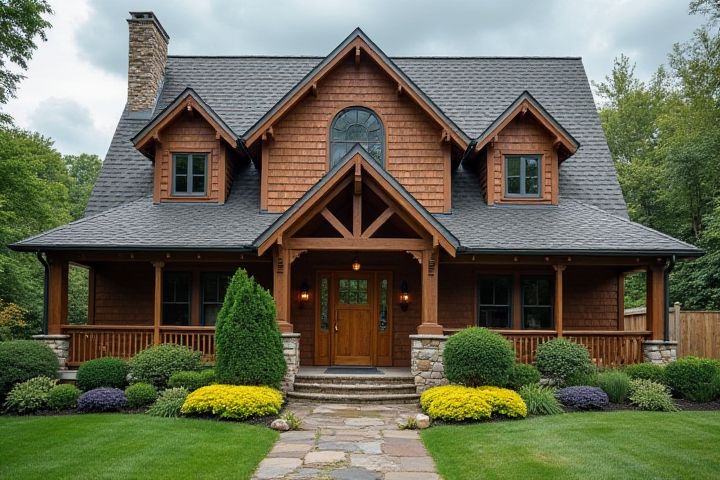
The best house style for you depends on your personal aesthetic preferences, lifestyle needs, and the local climate. Contemporary designs often emphasize clean lines, open floor plans, and sustainable materials, ideal for those seeking modernity and eco-friendliness. Traditional styles, such as Colonial or Craftsman, offer timeless charm with rich architectural details and a cozy ambiance, perfect for families. If maintenance is a concern, consider a minimalist style that uses durable materials and fewer embellishments. Ultimately, your chosen style should harmonize with the environment and enhance your everyday living experience.
What House Style Is Best
Architectural preferences
For a modern architectural preference, the minimalist style stands out with its clean lines, open spaces, and functional design elements, emphasizing simplicity and the beauty of materials. Alternatively, the mid-century modern style showcases organic shapes and large windows, creating a seamless blend between indoor and outdoor environments, ideal for natural light enthusiasts. If you appreciate classic aesthetics, the Victorian style offers intricate details and rich colors, reflecting historical craftsmanship and ornate designs. Each style caters to different tastes and lifestyles, making it essential to consider your personal preferences when selecting a home design.
Climate considerations
When considering climate-friendly house styles, the modern sustainable design stands out for its efficient energy use and environmental impact reduction. Features such as passive solar design maximize natural light and warmth, while materials like reclaimed wood and recycled steel minimize resource consumption. Green roofs and enhanced insulation systems play critical roles in temperature regulation, ultimately reducing utility costs and enhancing indoor comfort. By prioritizing these elements, you can create a home that not only meets your aesthetic desires but also actively contributes to a healthier planet.
Local building codes
When choosing a house style that aligns with local building codes, consider the architectural elements that meet structural and aesthetic requirements. Craftsman-style homes often comply well due to their use of natural materials and efficient energy design, making them a popular choice in many regions. Alternatively, contemporary styles can offer flexibility in design while adhering to modern safety standards and sustainability practices. Always consult with local authorities and building regulations to ensure your selected style is both compliant and suited to your environment.
Budget constraints
When considering budget constraints, the best house styles typically include ranch, cape cod, and tiny homes. Ranch-style homes offer single-story living, reducing construction costs and making them energy-efficient, while cape cod designs facilitate the use of simple, cost-effective materials. Tiny homes provide an affordable housing solution by maximizing space efficiency and minimizing construction expenses. You can achieve a modern aesthetic within these styles, ensuring that your home remains functional and visually appealing without overspending.
Maintenance requirements
The best house style for low maintenance requirements is a single-story ranch-style home, which typically features a simple design with fewer rooflines and minimal exterior detailing. Materials such as vinyl siding and composite roofing can significantly reduce upkeep, as they withstand harsh weather and require less frequent painting or repairs. A landscape featuring drought-resistant plants and hardscaping reduces the need for extensive yard maintenance, allowing for a more hands-off approach. For energy efficiency and longevity, consider houses with ENERGY STAR-rated windows and appliances, which can save both time and money in the long run.
Resale value potential
When considering resale value potential, a contemporary house style often stands out due to its modern aesthetic and energy-efficient features. Homes designed with open floor plans, large windows, and sustainable materials appeal to today's buyers seeking both functionality and aesthetic appeal. Additionally, incorporating popular elements such as minimalist design, smart home technology, and outdoor living spaces can significantly enhance the property's marketability. You may also find that traditional styles, like Craftsman or Colonial, maintain a strong appeal in certain neighborhoods, combining timeless charm with lasting value.
Floor plan functionality
A contemporary house style often emphasizes open floor plans, maximizing functionality and space utilization. This design typically features a seamless flow between communal areas, such as the kitchen, dining, and living rooms, allowing for enhanced interaction and flexibility. You may also consider incorporating multi-functional rooms that can adapt to various needs, such as a home office that doubles as a guest room. Overall, focusing on user-friendly layouts and the efficient arrangement of spaces can significantly enhance the overall livability of your home.
Aesthetic desires
For aesthetic desires, the Modern style stands out due to its clean lines, minimalistic features, and emphasis on open spaces. With a color palette often consisting of neutral tones, this style incorporates natural materials like wood, glass, and metal to create harmony. Mid-century modern furniture pieces offer a blend of functionality and artistry, perfect for those who appreciate both form and function. Incorporating large windows can enhance natural light, providing an uplifting atmosphere in your living space.
Energy efficiency
Passive house design is highly regarded for energy efficiency, achieving up to 90% less energy consumption for heating and cooling compared to conventional structures. This style emphasizes thick insulation, high-performance windows, and an airtight envelope, which collectively minimize thermal bridging and heat loss. Incorporating renewable energy sources, such as solar panels, can further enhance sustainability, potentially allowing homeowners to attain net-zero energy status. If you're looking to reduce your carbon footprint and save on utility bills, a passive house may be the optimal choice for your needs.
Environmental impact
The most effective house style for minimizing environmental impact is the modern sustainable design, often characterized by energy-efficient systems and the use of sustainable materials. Features such as solar panels can reduce energy costs by up to 70%, while passive solar design harnesses natural sunlight for heating, ultimately lowering reliance on traditional energy sources. Incorporating green roofs and rainwater harvesting systems can improve biodiversity and decrease water consumption by as much as 50%. Opting for locally sourced materials can further enhance sustainability, reducing transportation emissions and supporting local economies.
